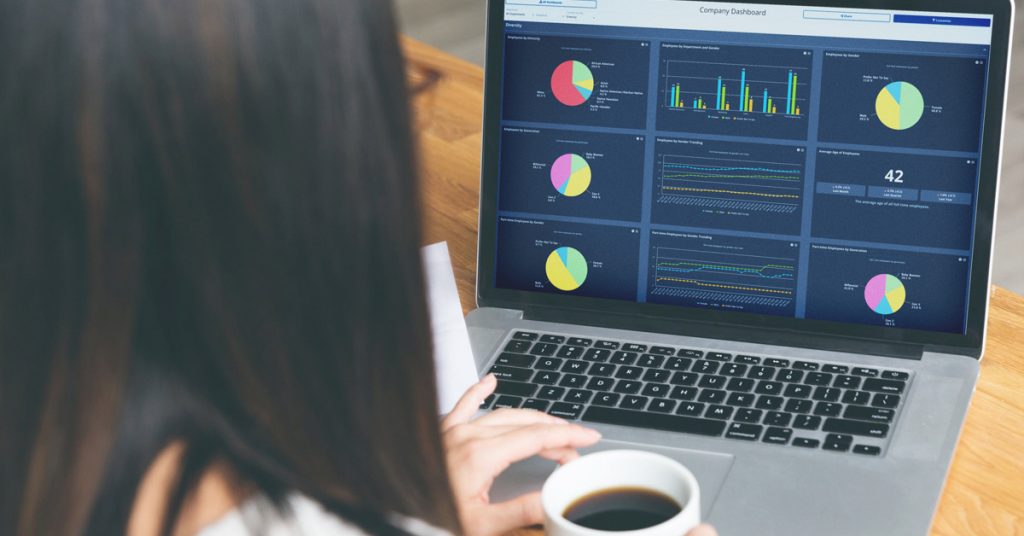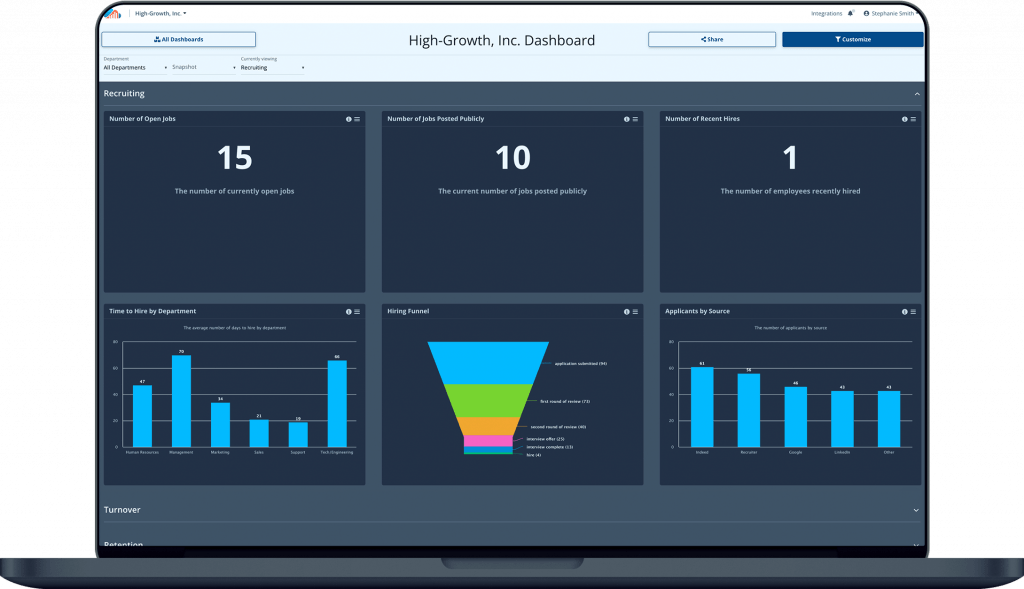Typically, HR analytics staff are viewed as report-generators, but what if you could tap into more of their potential, increase their efficiency, and maximize their contributions to your organization’s strategic objectives?
What if the real-time analysis of data could take place and produce insights such as underlying workforce trends, risk mitigation, and predictive models in moments? David Creelman, CEO of Creelman Research, and known as a people management expert, has said, “The reality is that most HR reporting teams don’t have the mandate, tools, or skill set to do analytics. Hoping that a team already up to their necks in producing routine reports can suddenly start doing sophisticated analytics, such as predicting turnover or using machine learning, is unrealistic.”
What if actual people analytics can be done and is realistic? What if you can unlock more value in your HR analytics functions that will contribute to your organization’s objectives and financial performance? Let’s discover how by starting with basic descriptions and responsibilities of HR Analysts.
What is an HR Analyst and what do they do?
A human resources analyst is responsible for collecting, managing, and analyzing data relevant to the key functions of HR. HR Analysts, also known as People Analytics Specialist or HR Business Data Analyst, work with the human resources generalist, business partners, specialists, and senior HR managers to make data-driven decisions based on trends and insights. The core theme of their responsibilities includes data analysis.
Typically, HR analysts are responsible for compiling, structuring, and analyzing data to develop insights and conclusions that help streamline HR processes throughout an organization. These positions can vary in responsibilities based on the size of the organization.
For example, let’s say you have a medium-sized business. Your priorities for an HR analyst might include working directly under the HR manager to keep them updated on the status of candidate questions, recruitment concerns, staffing issues, and to collect relevant statistics of your workforce. The HR analyst would probably also analyze appropriate compensation plans for job openings, develop job descriptions for needed positions, and conduct an employee satisfaction survey to gather more data about professional development/training opportunities provided to your staff.
Another example might be of a large organization. There is more data involved in larger organizations, so an HR analyst may be more specialized into certain areas, such as a benefits analyst, compensation analyst, or HR systems analyst.
The HR analyst role and responsibilities truly depend on your organization’s size, hierarchy, and industry.
HR Analyst Requirements
So, what’s required with regard to skills, abilities, experience, and education to be an HR analyst? This also depends on the overall role of the HR analyst for your organization. But typically, the following are required no matter the size, hierarchy, or industry of your organization.
Skills and Abilities
- A complete understanding of Microsoft Office programs (Excel, PowerPoint, Word).
- Working knowledge of various Human Resource Information Systems (HRIS) – some of the HR platforms that Employee Cycle supports include Zenefits, Sapling, Lattice, and TriNet, to name a few. View our growing list of integrations on our Home Page.
- Complete knowledge of HR practices, laws, regulations, and policies – SHRM and the U.S. Department of Labor are great places to start.
- Awareness of HR best practices of your industry.
- Methodical knowledge and understanding of key HR processes, their effects on how your HR department works, and how to manage those processes.
- Complete knowledge of data analysis tools, software, and techniques.
- Knowledge of various modeling, your organizations strategic metrics, and team KPIs.
- Excellent verbal, written, and oral communication skills.
- Due to the sensitive data on each employee, an ability to maintain strict discretion and confidentiality is critical.
- To resolve data issues, critical thinking and problem-solving skills are key.
- Excellent research and analytical skills are necessary to effectively analyze the HR data.
Education and Experience
- A bachelor’s degree in Business Administration, Human Resources Management, or any related field.
- A master’s degree is not typically a requirement, but larger organizations may prefer it.
- At least 1–3 years of experience in the HR field.
- Although HR certifications are not absolutely necessary, they may be valued at your organization. The most desired are the SHRM-CP or SHRM-SCP certification from SHRM.
- At least one year of experience in HR analytics or data analysis.
- Being certified on using specific HR software is an added plus point.
Importance of an HR Analyst
Many organizations are starting to realize that the HR analyst role is crucial to running the most important part of the company — its people. As one of the most vital positions in the human resources world, HR analysts are given the duty of ensuring that all employees and managers are informed for data-driven decisions.
They’re responsible for researching and presenting data, developing reports and metrics, conducting meetings to address staffing issues, writing detailed presentations for management, troubleshooting data, assisting in the implementation of HR programs, coaching new team members, designing continuous improvement initiatives, and ensuring compliance and adherence to policies and guidelines. HR analysts can also work with HR directors to design an efficient department budget by ensuring job responsibilities are assigned to appropriate employees through performance evaluation.
Typical Salary of an HR Analyst
According to Glassdoor, as of January 2022, the national average salary for an HR analyst is $66,625/year in the United States. The career growth salary trajectory for an HR analyst is Senior HR analyst ($83,981/yr) to Senior Manager of HR ($108,591/yr).
When you are investing this level of salary into an HR analyst, wouldn’t you want to ensure they are providing high-value workforce analysis for your organization, rather than just reactive reports with limited value? What if you could ensure that your HR analyst is proving maximum value to the organization by harnessing their data-savvy to tackle questions that matter most to your leadership, managers, and HR team?
A Single Source of Truth for HR Data
Many organizations now use Employee Data Platforms (aka HR data warehouse or people analytics platforms) to gather workforce data into one hub that allows HR analysts to automate the collection and validation of their data and provide more time to conduct high-value analysis. This can give your organization a competitive advantage. For example, what if your organization could generate faster hiring salary offers (using industry benchmark data) to key talent when candidates are considering opportunities for multiple organizations? Would that be a huge benefit to your team? This is where Employee Cycle, the first Employee Data Platform in the world comes into play.

If your organization is like most, your CEO is most concerned about the bottom line. So, the numbers that the HR analyst contributes that affect or influence the bottom line will definitely get the CEO’s attention. Wouldn’t it be a great benefit for your HR team to move from the traditional focus of optimizing operations and filling open positions to getting your HR analyst working to uncover untapped potential, mitigate risks, and support strategic goals?
Lastly, what if your HR analyst could leverage data, trends, and insights to assist your leaders in proactively seeking out blind spots? The last two years of the pandemic have shown us that proactively looking at economic trends and political environments will help organizations know if there will be a shortfall in the recruitment pipeline in the future, for example. With your HR analyst freed from just generating reports, they can now probe for weak spots in your workforce; drill-down data by demographics, job function, even office location; and much more. This type of HR analytics maturity is essential for your organization to remain competitive and nimble in these ever-changing times.
Move From Reactive to Proactive Analysis
How can you empower your HR analysts to take a proactive role in your organization’s workforce strategy? By using the right technology to automate the majority of the data collection work.
Instead of using your HR analysts’ valuable time to report on what happened in the past, provide a single hub of data to enable them to bring problems into the light and recommend areas/solutions for investment proactively and early enough to make a difference.

At Employee Cycle, we work with your existing HR systems to make data easier to understand and more actionable for your HR analyst. Find out why Employee Cycle’s HR dashboard is the solution you are looking for. Schedule a demo now to make data-driven decisions to turn your HR analytics into a proactive rather than a reactive system.












